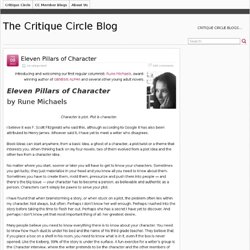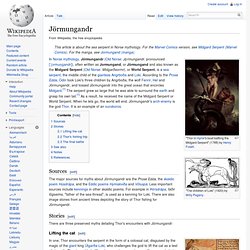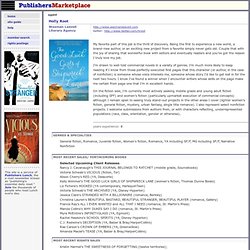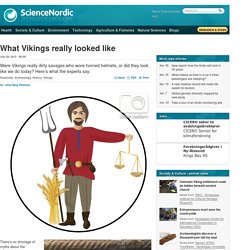

Eleven Pillars of Character » The Critique Circle Blog. Introducing and welcoming our first regular columnist: Rune Michaels , award-winning author of GENESIS ALPHA and several other young adult novels.

Character is plot. Plot is character. I believe it was F. Scott Fitzgerald who said this, although according to Google it has also been attributed to Henry James. Whoever said it, I have yet to meet a writer who disagrees. Book ideas can start anywhere, from a basic idea, a ghost of a character, a plot twist or a theme that interests you. No matter where you start, sooner or later you will have to get to know your characters. I have found that when brainstorming a story, or when stuck on a plot, the problem often lies within my character. Many people believe you need to know everything there is to know about your character. But what do we HAVE to know? I believe in these eleven pillars listed below. Keep in mind that when you first go through the list your answers should be short, one sentence at the most. Then write! Her childhood Her parents. Submissions «
Welcome to Buzz Books!

We publish compelling, entertaining stories in fiction and creative non-fiction. Check out our books page and author page to see who and what we have published and plan to publish. We’re excited about our list and line-up. Please include in all queries: Your pitch and contact information in the body of your email.A subject line that clearly states the intention of your submission, as detailed in the submission guidelines.Your social media credentials, including your Facebook author page, Goodreads account, Twitter handle and/or blog or website URL. Compensation will vary by author and by project and will be outlined in the offer letter. A few more tips about our Hive: Fenrir. Hel (being) In the Poetic Edda, Prose Edda, and Heimskringla, Hel is referred to as a daughter of Loki and Angrboða, and to "go to Hel" is to die.

In the Prose Edda book Gylfaginning, Hel is described as having been appointed by the god Odin as ruler of a realm of the same name, located in Niflheim. In the same source, her appearance is described as half black and half white flesh-coloured and further as having a gloomy, downcast appearance. The Prose Edda details that Hel rules over vast mansions with many servants in her underworld realm and plays a key role in the attempted resurrection of the god Baldr. Scholarly theories have been proposed about Hel's potential connections to figures appearing in the 11th century Old English Gospel of Nicodemus and Old Norse Bartholomeus saga postola, potential Indo-European parallels to Bhavani, Kali, and Mahakali, and her origins.
The Poetic Edda, compiled in the 13th century from earlier traditional sources, features various poems that mention Hel. Jörmungandr. Sources[edit] The major sources for myths about Jörmungandr are the Prose Edda, the skaldic poem Húsdrápa, and the Eddic poems Hymiskviða and Völuspá.

Less important sources include kennings in other skaldic poems. For example in Þórsdrápa, faðir lögseims, "father of the sea-thread", is used as a kenning for Loki. There are also image stones from ancient times depicting the story of Thor fishing for Jörmungandr. Stories[edit] There are three preserved myths detailing Thor's encounters with Jörmungandr: Lifting the cat[edit] Thor goes fishing for the Midgard Serpent in this picture from an 18th-century Icelandic manuscript. Tami Cowden. Archetypes, Myths and Characters. These tips are excerpts from the Storybuilder User's Manualand are Copyright© 1996-1998 by Seven Valleys Software, Glen Rock, PA.

An archetype is a prototype or model from which something is based. The character archetypes listed here derive from Joseph Campbell's The Hero with a Thousand Faces and are deeply rooted in the myths and legends of many cultures. A significant character's role can often be associated with one of these archetypes, because storytelling is as old as these myths and legends and is how they were handed down to us. Archetypes connect your story to the rich heritage of all storytelling. Hero The essence of the hero is not bravery or nobility, but self-sacrifice. The hero's journey during a story is a path from the ego, the self, to a new identity which has grown to include the experiences of the story. The hero must learn in order to grow. Publishers Marketplace: Holly Root. My favorite part of this job is the thrill of discovery.

Being the first to experience a new world, a brand-new author, or an exciting new project from a favorite simply never gets old. Couple that with the joy of sharing that wonderful book with editors and eventually readers and you’ve got the reason I truly love my job. I’m drawn to well-told commercial novels in a variety of genres. I’m much more likely to keep reading if I know from those perfectly-executed first pages that this character (or author, in the case of nonfiction) is someone whose voice interests me, someone whose story I’d like to get lost in for the next two hours. What Vikings really looked like. The fine decoration of the Oseberg ship in Norway, which was buried in the year 834, provides clues to what Vikings looked like.

Inside the ship were two women and the archaeologists believe the ship has served as a sarcophagus. (Photo: Annie Dalbéra) There’s no shortage of myths about the appearance of our notorious Viking ancestors. To find out more about these myths, ScienceNordic’s Danish partner site, videnskab.dk, asked its Facebook readers to list their favourite myths about what the Vikings looked like.